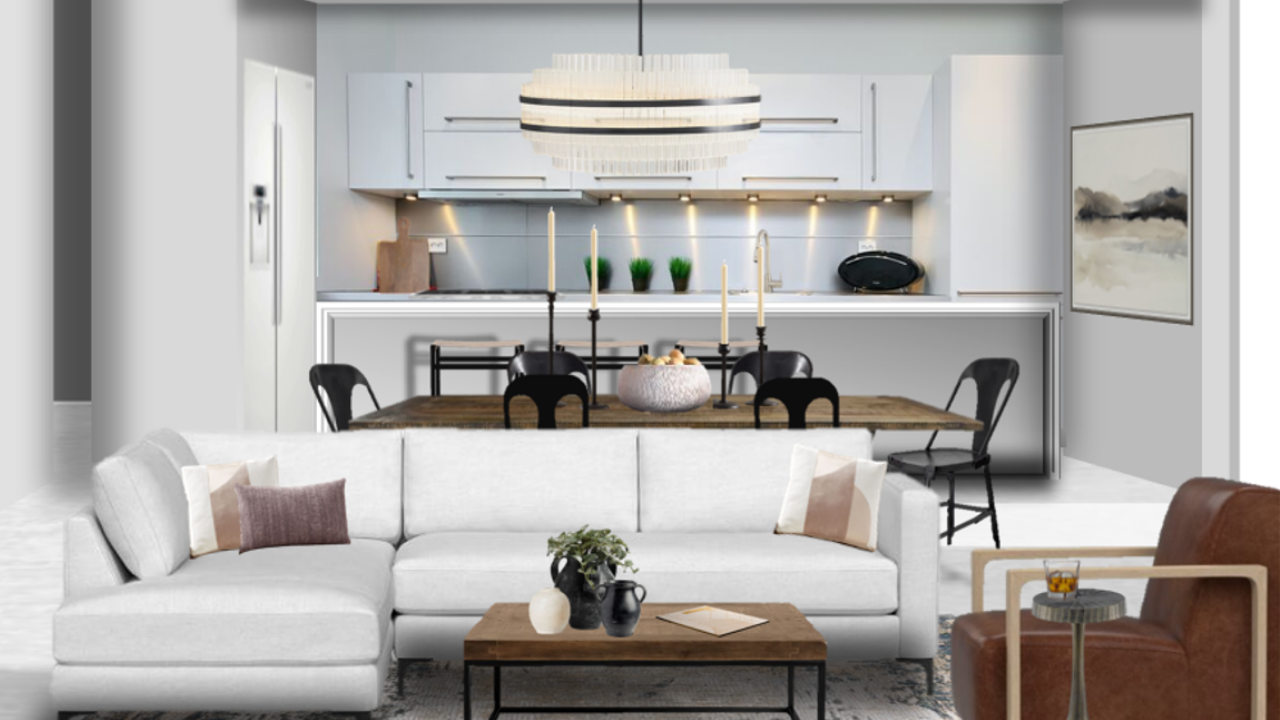The open concept layout is everywhere. I see it on TV and in magazines. It’s on YouTube in various channels from design focused experts to people doing home tours.
Most of what’s said is that the people wanted more space because they were tired of living in closed off separate spaces.
There’s definitely a very attractive aesthetic to be had with open concept. I feel it leans more contemporary.
When I think about open concept, I picture a chic, high rise city apartment with tall ceilings and giant windows that let light flood in.
However, if you have an old farmhouse in the country, nobody’s saying you can’t create a totally beautiful and functional open concept.
The look can contrast the simplicity of the country and it can enhance the natural beauty of the outdoors if you frame the views with those giant windows.
Dictionary.com defines Open Concept as: Adjective, (in a house or office) having few or no internal walls or partitions Also called (in Britain and certain other countries): open-plan
Few or no internal walls. Some might think, heck yeah that sounds amazing! Other might think, no way, that’s like being stuck in the same room all the time, boring!
If you’re thinking about going open plan or open concept with your space, I’ve got 7 questions to ask yourself, especially if you’re planning on living in a small house.
Let’s get to it.
Are You Okay with Less Privacy?
The thing I hear most often from my clients with open concept homes is that they can’t get away.
They’re always pretty much in the same room. That means the TV is on and probably too loud. The tween is practicing piano and let’s say she’s not Mozart…
The teen is foraging through the fridge and commenting on everything he hates while opening and closing the crisper drawer with his foot and bemoaning the snack choices.
While this theatre of life is going on, in complete openness, you’re trying to cobble together one peaceful thought in the small nook off to the side of the kitchen.
Now imagine that everyday for as long as you own your house. Yes, that’s very specific and probably somewhat familiar, right?
Source: David Todd McCarty, Unsplash
Now if your house is less than 2000ft2, that typically means the room you’re sitting in now is the only room for the specific function it serves in the house. Meaning, if you’re in the dining area, that’s the space reserved for that. Or, you’re in the living room because there’s no family room or vice versa. God help you if you’re in the bathroom because it’s probably the family bathroom and we all know how that goes.
Open concept seems like a dream. It’s modern, clean looking and spacious. But, as you can see above, those same features that drew you to it can become the first things you end up hating the most.
2. Do You Know How to Create Separation in Large Spaces?
So, nobody lives in one huge open space. Even the smallest homes have some form of space definition.
Source: Ula Kuźma, Unspash
Any space comes with the need to be finished. You’ll always want to plan and edit it until it’s how you want it to be. That’s the fun part. Take it form the decorator, even frustrating spaces can end up beautiful with the right plan in place.
You might want to add a piece of furniture to differentiate spaces in an open concept room. Place a etagere between the front entry and the living room to create a foyer. This space here has a hall table and bench to signify the functionality of the entry space. It appears to have a sofa table off the the right which also helps to define separation between the living room and the entry.
Little tricks like that really help to break up open concept spaces.
Source: Collov Home Design, Unsplash
Another way to define different areas is to use area rugs to create some visual separation. If your dining and living areas are in the same open area, anchor the furniture in each group with an area rug.
If you need more permanent separation, think about defining spaces with glass wall panels or frame in a cased opening that partially closes one space from another while still allowing it to be open. A cased opening is a great way to create more function for a small home.
Source: Tina Witherspoon, Unsplash
You can create built in shelves or cabinetry on either side of the cased opening. This is extra space for décor, books, collections. Plus, the slight separation will give the space better sound insulation.
3. How Do You Use Your Space Now?
Chances are you won’t wake up the first day in your new open concept home and change how you live day to day. So, it’s important to understand how you’ll want to continue using the new space with how you’re accustomed to living.
If you love to host large gatherings, then a small dining space probably won’t fit the bill. You’ll need that open concept area where people can sit at the table and at the kitchen island while you prepare food and visit.
Source: khloe Arledge, Unsplash
If you’re more accustomed to small gatherings, the separate dining room might be ideal because you’ll have a couple of people over for dinner and you can retire to the living room after for drinks or desert. You’re already used to more intimate gatherings and you may find the openness off putting.
Think about how you use the other areas of your home and consider if your routines are suitable for open concept living.
Source: Tatiana, Pexels
Think about things like:
Do you work from home? Not having a defined office space could get old fast if you’re trying to work and that theatre of life performance is playing every day with a matinee Saturday and Sunday. (Tip: Having a space to get away from it all is kind of important.)
Source: Ketut Subiyanto, Pexels
Are you a foodie with kitchen gadgets galore? If so, you may struggle to find storage for all that stuff in a small house open concept kitchen. (This is important to think about when looking at small condos with predetermined floor plans because adding in additional storage might not be possible.)
Source: Maria Orlova, Pexels
Try to remember what attracted you to a smaller house to begin with.
Was one big room on your list or did you like the idea of defined spaces? That may seem simple but asking yourself that question can help you get a handle on exactly what you need from your house.
4. Will You Trust Your Gut When Making Your Decision?
We all have that little voice that says I don’t feel right about this. You can be projecting enthusiasm and excitement on the outside but feel conflicted on the inside.
That’s your gut telling you there’s some more stuff to figure out before making up your mind.
Your emotions will tell you a lot about what you like and don’t like and that will help you make better decisions if you listen to your instincts.
Source: Jonathan Andrew, Pexels
5. Do You Know Where to Find Inspiration?
If moving forward on an open concept home still has you on the fence, try getting out of your head and in real life.
Take a tour of some model homes
Go to both open concept and defined models and keep your eyes open for anything that gives you pause. Pay attention to how you feel as you walk through each home because you’ll be able to learn a lot from how each concept makes you feel.
Source: Dillon Kydd, Unsplash
Do you feel like separate rooms make you claustrophobic or are you inspired by making a smaller space over the way you’d like it?
Does a large space fill you with inspiration or does it leave you feeling stressed out because you don’t know where to put anything?
For example, think about wall space. If you love decorating your walls with pictures or art, you’re going to have less wall space to work with in an open concept home. That means you’ll have to pull back on your wall décor. It might not seem like a big deal now but it could be really disappointing once you’re living in the space day in and day out.
If the models are furnished, look at how they’re staged. This is great for getting ideas for arranging your own space but also take notes on how the space feels.
Source: Evan Dvorkin, Unsplash
Take pictures and make notes on how big the furniture is. Does it feel too big or too small for the space? Is there enough room to talk around furniture, to pull dining chairs out away from the table and then sit down?
Make sure to write down what doesn’t feel right to you so you can address it with as you’re planning your own layout.
6. Are You 100% Sure You Want Open Concept?
This is a total devil’s advocate question, but I think it’s pretty valid. Hear me out…
You may love the idea of open concept. You might even have 30 Pinterest boards all about open concept layouts.
I say forget about open concept or defined spaces for a minute. Take some time to think about the levels of separation you want.
Consider how much visual separation you want.
Does a cased opening that frames a space feel better than no definition at all?
Source: fran Hogan, Unsplash
Or, do you want a closed kitchen with a pass through so you can still visit with guests but they don’t have to see all the dishes you tore through preparing the incredible dinner for them?
Think about sounds
When living in an open concept space you also have to consider that you don’t have walls to absorb sound. Loud TV’s or the teen playing video games with his friends will travel, unobstructed, through an open space. That can ruin a nice visit with a friend or a relaxed conversation over dinner.
Think about smells
Cooking smells. Your seafood extravaganza dinner was spectacular but even with the exhaust fan going, there’s still a lingering something in the air. Now imagine that aroma permeating effortlessly through the entire open space.
Source: Caroline Attwood, Unsplash
In general, open spaces feel less cozy than defined spaces. That’s more of a visual thing. Less cozy can also be a side effect of heat retention.
Basically, walls help to keep rooms warmer in the winter because they act as insulating barriers inside the house. No walls means higher heating bills.
If you live in a warm climate, open spaces that stay cool is a plus. If you’re a cold climate cutie, you’re going to be shelling out more for heat in an open concept home.
Source: Karolina Grabowska, Pexels
That brings me to the last question:
7. Have You Truly Factored in Costs?
Say you’ve decided to stay in your current house but you’re going forward with removing walls and creating the open concept you’re after. Have you prepared expense?
It’s not all about the money.
Source: Charles Deluvio, Unsplash
There is an expense of time – renovation projects are not completed in 28 minutes with 4 commercial breaks. I don’t care what HGTV leads you to believe.
Removing walls is the easy part.
Consulting with an architect to determine load barring walls and weight distribution, hiring a designer or decorator to choose finishes and to make the newly open configured space work and then the TEAM of trades people that will bring the plan to life: construction, plumbing, electrical, drywallers, painters, the list goes on. All are expensive and it adds up quick.
Source: Ryan Ancill, Unsplash
Time equals money is the true definition of a renovation project.
You could run into snags that send the whole project back to the drawing board which delays progress, holds up construction which costs more money.
Planning the financials of a project like this is a topic for another blog entirely but paying half to 3 quarters the net worth of your house is not out of left field for costs associated with reconfiguring and renovating a home.
There’s a lot of things to consider when making any decision about our homes and this is not a compendium for everything you should do. It’s rather a post on using your instincts as a compass to guide you toward making rational and well thought out decisions about if open concept layouts are right for you.
Considering a Renovation Project? Read This First
What You Should Know Before Starting a Home Improvement Project
Before you hire a pro or pick up a hammer, it’s important to think about the long-term impact these renovations will have on your home. Before you dive into your home improvement project, do your research on the ROI of your renovations before you start. Here’s how:
I’d love to hear what you think.
Do you live in a small, open concept space?
Are you downsizing and considering open concept because you’re tired of defined rooms?
Do you have regrets about moving into an open concept space?
What else do you do to help you make decisions about your home?
Join the Fun!
If you enjoyed this post and you want to keep seeing my weekly blog, the best way to do that is to subscribe.
You can subscribe by downloading my 11 Secrets Only Designers Know to Make Your Space Rock. If you’re curious about how decorators and designers make a home look magazine ready, you’ll love taking a gander at these 11 secrets. You’ll learn how to style your room from the floor up and it will work for ANY space you have.
I write about small space design and decorating, sustainable furniture options, positive self care and a variety of do-it-yourself home décor.
I’d love to connect with you!
“This man is a plant shaman. He not only designs beautiful rooms, he’s got a green thumb that works like magic! My peace palm never looked better.”
“Michael Helped me to get my home office in magazine ready form. Thank you a million times for helping me figure this room out. It’s now my favorite room!”
Michael is Principal designer and blogger at Michael Helwig Interiors in beautiful Buffalo, New York. Since 2011, he’s a space planning expert, offering online interior e-design services for folks living in small homes, or for those with awkward and tricky layouts. He’s a frequent expert contributor to many National media publications and news outlets on topics related to decorating, interior design, diy projects, and more. Michael happily shares his experience to help folks avoid expensive mistakes and decorating disappointments. You can follow him on Pinterest, Instagram and Facebook @interiorsmh.

























